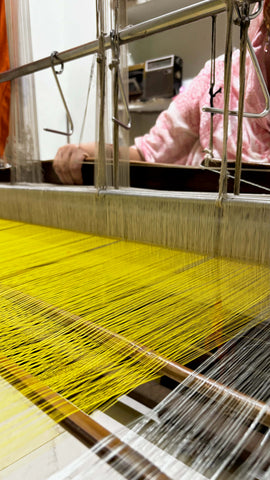
Digital Ghettos: Why Artisans Can’t Thrive in Tech’s Walled Gardens
Handicrafts like hand block printing and dyeing have historically provided vital employment and income-generating opportunities in rural India, once serving as the mainstay of the economy. In the 21st century, however, these traditional crafts are no longer the drivers of economic growth. Centres where these crafts have historically been practiced have largely been left out of the broader Indian growth story over the last 35 years. In the early 90s, textile exports significantly contributed to economic growth, primarily supported by investments in mechanization and automation. This industrial shift further marginalized traditional handicrafts. The subsequent move to software and IT-enabled services in the late 1990s and early 2000s cemented IT as the primary engine of Indian economic expansion.
The IT revolution, accompanied by the rapid adoption of smartphones, ICTs, and social media, promised better access to information and a level playing field. Further advancements like the introduction of GST in 2017 and UPI-based payment systems eased the complexity of doing business, communication, and payment transfers. Yet, these advancements have disproportionately benefited urban centres, leaving those engaged in handicrafts still largely on the other side of the digital divide.
Even with a smartphone in hand, many artisans in rural India struggle with understanding complex platform interfaces, or with accessing affordable digital marketing tools necessary to truly leverage these advancements. While mobile phone connectivity, internet data access, smartphone adoption, and e-commerce platform usage have indeed increased manifold over the last decade – a trend significantly hastened by the COVID-19 pandemic – this narrative paints only a partial picture.
The digital landscape, despite its apparent growth, is largely dominated by "walled garden" platforms, which are primarily ad-driven businesses. These platforms promise immense opportunity and a level playing field, yet this promise often proves illusory.
Several features within these walled gardens tilt the scales significantly in favour of those who already possess substantial economic, social, and cultural capital. Early entrants into these walled gardens found considerable success by staking their claim to large swathes of internet real estate. In stark contrast, late entrants or newcomers must now fight and scrape to carve out small niches for themselves.
These walled gardens are no longer virtual "gardens of Eden"; they have evolved into digital ghettos that offer limited mobility and opportunity. If one were to extend the logic of diffusion of innovations to Web 2.0, it becomes clear that late adopters, particularly those starting with limited capital, have little meaningful gain from adopting these technologies.
What transforms these walled gardens into digital ghettos for artisans? The answer lies in several critical factors.

Algorithms Make Artisans Invisible
Walled gardens use algorithms that recommend products and services to consumers based on their searches. The ‘recommendation algorithm’ sifts through millions of photos, alternative text, and descriptions to “see”, identify, and classify them. The process by which algorithms ‘see’, identify, and classify images is called computer vision.
Computer Vision and AI-Driven Algorithms
The algorithm is trained to look for specific details like colour, fabric, texture, and weave using training data. The training of the algorithm may favour certain types of photos over others. For example, if an artisan producing sarees takes a photo of a saree draped on a chair or on the floor, the algorithm may not recognize it as such. The algorithm may have been trained on photos of sarees draped on women in a particular style. Biases in training data could also lead to machine-made products being identified as hand-made.
The algorithm is also aided in its vision by markers such as alternative text and descriptions provided by the seller. Sellers often mislabel machine-made products as hand-made. Artisans who are unaware of these details often do not provide this information, thus rendering themselves invisible. Of course, one could argue that this problem is solved with digital skills training. However, this still does not solve the problem of mislabelling by sellers. The black box of algorithms makes it impossible to determine how algorithms distinguish between products uploaded by artisans and those by traders, or how algorithms distinguish between photographs of sarees made by machines and those made by hand.
To be ‘seen’ by an algorithm, an artisan must know the parameters used by the algorithm to identify and classify a product. Easier said than done. Big businesses employ teams of specialists to address this problem; resources that are not available to a time-poor artisan.
Even if an artisan does manage to take photos that an algorithm can ‘see’, the parameters are different for different platforms. To save time, the artisan is forced to choose one walled garden and is trapped there.
Content Bias and Engagement Focus
Algorithms tend to favour content that is engaging and relevant to the user. A skilled artisan, who may be capable of producing exquisite products, may remain invisible because they are unable to create engaging content.
Geographic Bias
Algorithms can favour local content, inadvertently creating a geographic bias. For example, if a user in Mumbai, Delhi, or Bangalore searches for a specific type of fabric, they are likely to be shown information about sellers located close to them. Artisans located in rural India do not show up on these search results. Consumers reside in urban centres while producers are located in rural centres. Geographic bias of algorithms adds one more layer of invisibility.

Social & Cultural Capital
Social and Cultural capital are often overlooked by advocates of digital platforms. Artisans, especially independent ones lacking social networks, turn to social media platforms or e-commerce platforms hoping to reach customers. Merely posting on these platforms is insufficient as the organic reach of a post has dropped drastically. At the time of inception, these platforms offered infinite reach for posts. Now, sellers are forced to spend on advertising to reach customers. This again requires specific knowledge of a platform's advertising interface and processes. This also requires sophisticated knowledge of consumers' tastes and preferences, which can be termed cultural capital. Most artisans in rural India do not possess this. Producers and consumers live in different worlds and realities that platforms do not bridge.
Let's say that an artisan sets up an e-commerce website. Their website may not be visible to the consumer due to geographic bias. More importantly, their website is not likely to show prominently in search results due to a lack of backlinks—essentially, links from other credible websites pointing to it. The higher the number of backlinks to a website, the higher its authority. The authority of a website has an impact on its position in the search page results.
Backlinks are a form of social capital. It is not possible to obtain these backlinks organically. One must network offline to connect with those who occupy positions of authority to secure these backlinks. This kind of networking requires access to influential social circles, which artisans often find exceptionally difficult to obtain.
Social and cultural capital play a significant role in shaping outcomes within walled gardens. Newcomers to walled gardens enter with hope, but the history of innovations has shown that late adopters of a technology often gain little from it.
Exacerbating Social Inequalities
Classification by algorithms provides visibility and opportunity to some segments more than others. This could lead to stratification of society. In India, the varna system has shown how classification can lead to stratification of society. Technology’s walled gardens have the propensity to do the same.
Walled gardens, far from helping create social mobility, have the propensity to deepen and harden existing social divides. The idea that economic growth can lead to social change is subverted by walled gardens. The very architecture of Web 2.0 effectively transfers and exacerbates real-life inequalities onto the internet; those who are marginalized in the physical world continue to be marginalized in the digital.
So, what is the core message here? We must build a compelling case for alternate digital public infrastructure that is genuinely designed to cater to the unique needs of artisans. This new digital ecosystem should prioritize increasing their global reach and facilitating the organic building of social capital, ultimately helping artisans escape the confines of their own geography and thrive in the digital economy. The new digital public infrastructure must not only simplify transactions and commerce but also foster social mobility. Computer vision and training of algorithms must be contextual and sensitive to cultural differences. Identification and classification by algorithms must be transparent and open to scrutiny. Lastly, artisans should not only be users of such infrastructure but also get a share in the profits.
_____________________________________________________________________________
Craft, Culture & Change at the Chaani Center for Social Research
I’m currently documenting the life stories of artisans in Rajasthan, capturing not only their traditional skills but how their livelihoods are shifting in the digital age.
From master weavers to block printers, I’m exploring:
· The textile value chain
· The role of social media in artisans’ lives and livelihoods
· Barriers to access, visibility, and the role of social networks
This work is a blend of interviews, photo essays, and digital ethnography — a look at how centuries-old traditions meet smartphones, reels, and hashtags.
If you’re interested in the intersection of social research, digital storytelling, and artisan-led economies, I’d love to connect and hear your thoughts.
